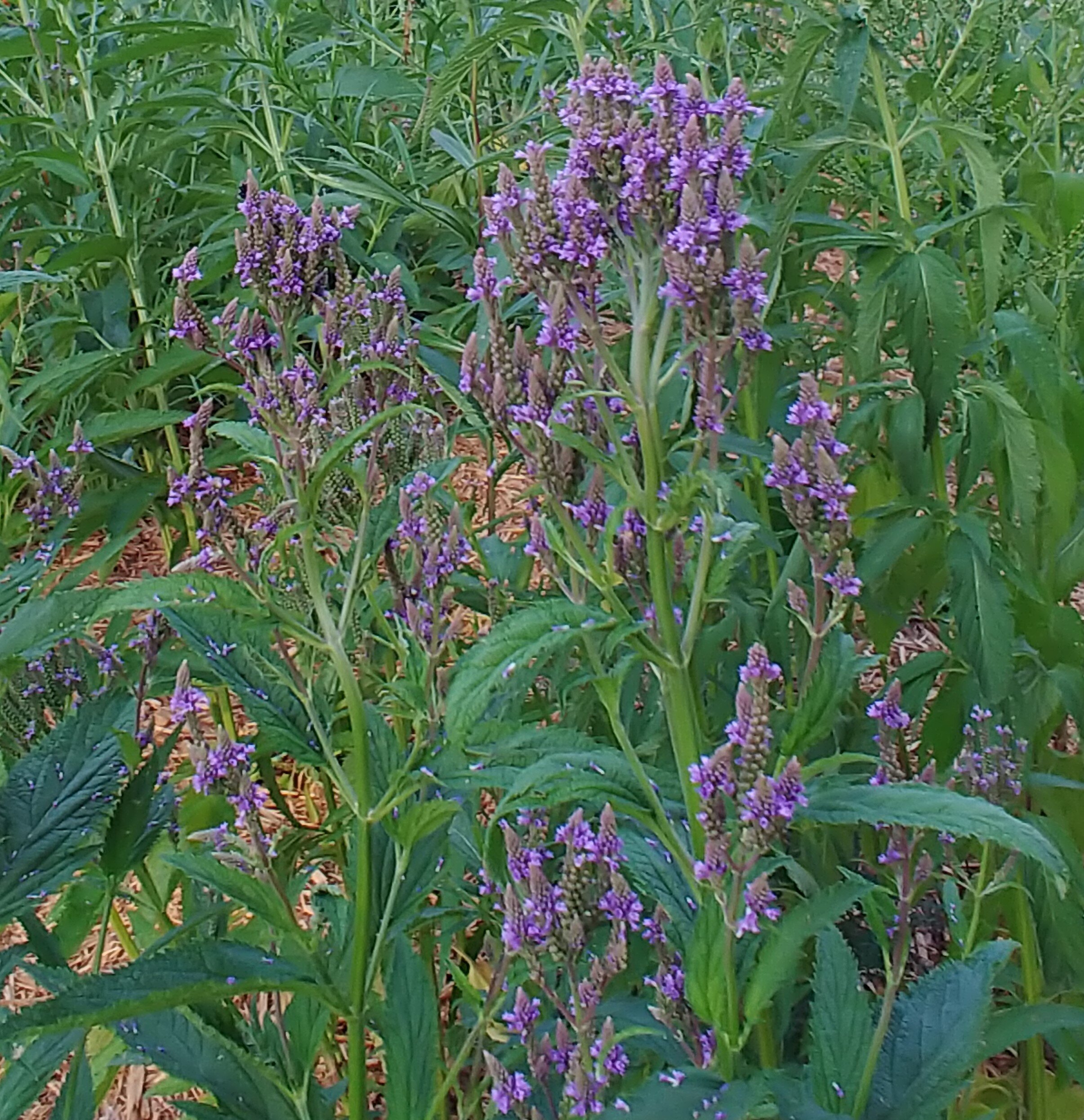Verbena hastata, Blue Vervain, Quart pot
Verbena hastata, Blue Vervain
FS, Zone 3, Blooms July - Sept., 5-6’ x 2’, Wet to medium, deer resistant.
Verbena hastata is a clumping perennial with stiff erect squarish stems. Leaves are opposite with coarse teeth. In summer, plants are topped by narrow spikey panicles of small tubular purple flowers. Plants thrive in full or part sun in moist or wet mucky soils. This tall stately plant provides architectural interest to your garden and also attracts a wide range of pollinators. The plant rarely needs staking. It can tolerate some flooding and standing water so it is a good candidate for a rain garden. The tiny tubular flowers bloom bottom to top and are long lasting when cut. It is a short-lived perennial that will self-seed.
Native to most of the temperate world. The plant has an ancient history. It is said priests cleaned the altars with the flower heads.
The flowers produce huge amounts of nectar over a long period. Vervain is a host plant for the Verbena moth. Leaving the seed heads on the plants in winter provides much needed food for birds and small mammals.
Attracts a wide range of pollinating insects, including Honey bees, Mining bees, Leafcutter bees, Bumble bees, Long-horned bees, Bee Flies, Native Wasps, Thick-Headed Flies, Syrphid Flies and butterflies. Host plant for Pearl Crescent, Silvery Checkerspot and wavy- lined Emerald Coenia moth.
Verbena hastata, Blue Vervain
FS, Zone 3, Blooms July - Sept., 5-6’ x 2’, Wet to medium, deer resistant.
Verbena hastata is a clumping perennial with stiff erect squarish stems. Leaves are opposite with coarse teeth. In summer, plants are topped by narrow spikey panicles of small tubular purple flowers. Plants thrive in full or part sun in moist or wet mucky soils. This tall stately plant provides architectural interest to your garden and also attracts a wide range of pollinators. The plant rarely needs staking. It can tolerate some flooding and standing water so it is a good candidate for a rain garden. The tiny tubular flowers bloom bottom to top and are long lasting when cut. It is a short-lived perennial that will self-seed.
Native to most of the temperate world. The plant has an ancient history. It is said priests cleaned the altars with the flower heads.
The flowers produce huge amounts of nectar over a long period. Vervain is a host plant for the Verbena moth. Leaving the seed heads on the plants in winter provides much needed food for birds and small mammals.
Attracts a wide range of pollinating insects, including Honey bees, Mining bees, Leafcutter bees, Bumble bees, Long-horned bees, Bee Flies, Native Wasps, Thick-Headed Flies, Syrphid Flies and butterflies. Host plant for Pearl Crescent, Silvery Checkerspot and wavy- lined Emerald Coenia moth.
Verbena hastata, Blue Vervain
FS, Zone 3, Blooms July - Sept., 5-6’ x 2’, Wet to medium, deer resistant.
Verbena hastata is a clumping perennial with stiff erect squarish stems. Leaves are opposite with coarse teeth. In summer, plants are topped by narrow spikey panicles of small tubular purple flowers. Plants thrive in full or part sun in moist or wet mucky soils. This tall stately plant provides architectural interest to your garden and also attracts a wide range of pollinators. The plant rarely needs staking. It can tolerate some flooding and standing water so it is a good candidate for a rain garden. The tiny tubular flowers bloom bottom to top and are long lasting when cut. It is a short-lived perennial that will self-seed.
Native to most of the temperate world. The plant has an ancient history. It is said priests cleaned the altars with the flower heads.
The flowers produce huge amounts of nectar over a long period. Vervain is a host plant for the Verbena moth. Leaving the seed heads on the plants in winter provides much needed food for birds and small mammals.
Attracts a wide range of pollinating insects, including Honey bees, Mining bees, Leafcutter bees, Bumble bees, Long-horned bees, Bee Flies, Native Wasps, Thick-Headed Flies, Syrphid Flies and butterflies. Host plant for Pearl Crescent, Silvery Checkerspot and wavy- lined Emerald Coenia moth.





